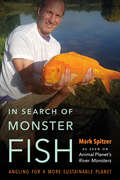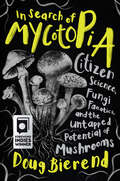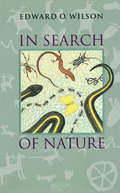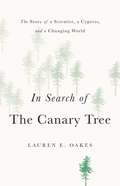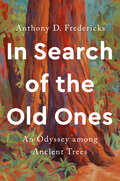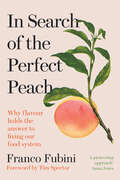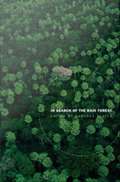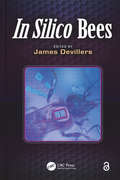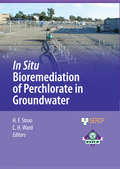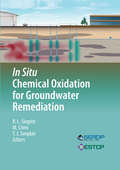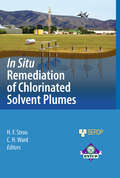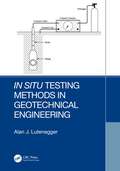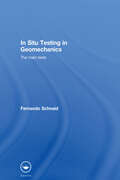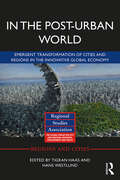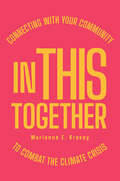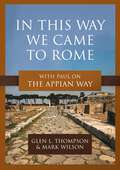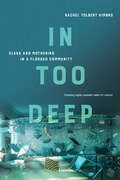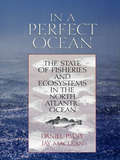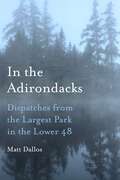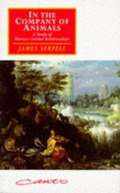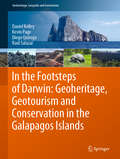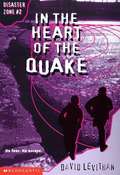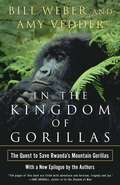- Table View
- List View
In Search of Monster Fish: Angling for a More Sustainable Planet
by Mark SpitzerIn Search of Monster Fish is an action-packed, knee-slapping ride into and out of the belly of the beast. Join extreme angler Mark Spitzer as he encounters man-eating catfish, ruthless barracuda, lacerating conger eels, berserk tarpon, and blood-curdling sharks in locales as exotic as the Amazon, Catalonia, the Dominican Republic, Senegal, and even in our own backyards. But this eco-odyssey isn’t just about meeting and releasing some of the most grotesque lunkers in the world. It’s about implementing solutions for problems as behemoth as global warming and issues as common as choosing what to eat for dinner. And as the ice caps melt at the rate of 1 percent annually, Spitzer battles his most epic goliath: a leviathan that dwells in the depths of us all, making us ask who the real monsters are, what our responsibilities truly are, and what we can possibly do to sustain our planet and ourselves when faced with such demonic disenlightenment. Spitzer then beats this whopper into submission by reframing his call to action and finding his own way. A new portal to the underworld has been opened in the cutting-edge literature of monster fish, and this is your entry ticket.
In Search of Mycotopia: Citizen Science, Fungi Fanatics, and the Untapped Potential of Mushrooms
by Doug Bierend&“Mushrooms are having a moment. [A] natural sequel for the many readers who enjoyed Merlin Sheldrake&’s Entangled Life.&”—Library Journal&“Bierend writes with sensual verve and specificity, enthusiasm, and humor. . . . [He] introduces us to the staggering variety of mushrooms, their mystery, their funk, and the way they captivate our imaginations.&”—The Boston Globe&“Nothing is impossible if you bring mushrooms into your life, and reading this book is a great way to begin your journey.&”—Tradd Cotter, author of Organic Mushroom Farming and MycoremediationFrom ecology to fermentation, in pop culture and in medicine—mushrooms are everywhere. With an explorer&’s eye, author Doug Bierend guides readers through the weird, wonderful world of fungi and the amazing mycological movement.In Search of Mycotopia introduces us to an incredible, essential, and oft-overlooked kingdom of life—fungi—and all the potential it holds for our future, through the work and research being done by an unforgettable community of mushroom-mad citizen scientists and microbe devotees. This entertaining and mind-expanding book will captivate readers who are curious about the hidden worlds and networks that make up our planet.Bierend uncovers a vanguard of mycologists: growers, independent researchers, ecologists, entrepreneurs, and amateur enthusiasts exploring and advocating for fungi&’s capacity to improve and heal. From decontaminating landscapes and waterways to achieving food security, In Search of Mycotopia demonstrates how humans can work with fungi to better live with nature—and with one another.&“Comprehensive and enthusiastic. . . . This fascinating, informative look into a unique subculture and the fungi at its center is a real treat.&”—Publishers Weekly&“If you enjoyed Merlin Sheldrake&’s Entangled Life . . . I highly recommend this book. . . . In the vein of Louis Theroux, Bierend journeys deep in the wonderfully strange subculture of the mushroom-mad.&”—Idler magazine&“Engaging and entertaining. . . .Bierend proves his skill as a science journalist through interviews and experiences shared with mushroom experts and citizen scientists.&”—Choice
In Search of Nature: Competition, Citizen Action, And Clean Power
by Edward O. Wilson Laura SouthworthPerhaps more than any other scientist of our century, Edward O. Wilson has scrutinized animals in their natural settings, tweezing out the dynamics of their social organization, their relationship with their environments, and their behavior, not only for what it tells us about the animals themselves, but for what it can tell us about human nature. He has brought the fascinating and sometimes surprising results of these studies to general readers through a remarkable collection of books, including The Diversity of Life, The Ants, On Human Nature, and Sociobiology. The grace and precision with which he writes of seemingly complex topics has earned him two Pulitzer prizes, and the admiration of scientists and general readers around the world.In Search of Nature presents for the first time a collection of Edward O. Wilson's seminal short writings, addressing in brief and eminently readable form the themes that have actively engaged this remarkable intellect throughout his career. The essays' central theme is that wild nature and human nature are closely interwoven, and, not without optimism, Wilson concludes that we are smart enough and have time enough to avoid an environmental catastrophe of civilization-threatening dimensions if we are willing both to redirect our science and technology, and reconsider our self-image as a species.From "the little things that run the world"-- invertebrate species that make life possible for everyone and everything -- to many scientists' emergent belief in the human species' innate affinity for other living things, known as biophilia, Wilson sets forth clear and compelling reasons why humans should concern themselves with species loss.In Search of Nature is a lively and accessible introduction to the writings of one of the most brilliant scientists of the 20th century. Imaginatively illustrated by noted artist Laura Southworth, it is a book all readers will treasure.
In Search of the Canary Tree: The Story of a Scientist, a Cypress, and a Changing World
by Lauren E. OakesThe surprisingly hopeful story of one woman's search for resiliency in a warming worldSeveral years ago, ecologist Lauren E. Oakes set out from California for Alaska's old-growth forests to hunt for a dying tree: the yellow-cedar. With climate change as the culprit, the death of this species meant loss for many Alaskans. Oakes and her research team wanted to chronicle how plants and people could cope with their rapidly changing world. Amidst the standing dead, she discovered the resiliency of forgotten forests, flourishing again in the wake of destruction, and a diverse community of people who persevered to create new relationships with the emerging environment. Eloquent, insightful, and deeply heartening, In Search of the Canary Tree is a case for hope in a warming world.
In Search of the Old Ones: An Odyssey among Ancient Trees
by Anthony D. FredericksAn extraordinary journey to visit the oldest trees in the United States that beautifully reveals the connection between humans and natural history— a perfect read for nature lovers and fans of The Hidden Life of Trees.Follow award-winning author Anthony D. Fredericks's adventures across the United States to uncover the remarkable secrets and lives of ancient trees. He introduces some of the oldest trees in the country using up-to-date research, interviews with scientists, captivating storytelling, and a contagious wonder for the natural world. Fredericks's visits to the trees turn readers into fellow travelers. Through firsthand accounts and scientific detail, these enduring trees come to life off the page.Each chapter begins with a time-travel story that immerses readers in Earth's past, as early as ~58,000 BCE, for a sweeping view of what was happening during human history when the ancient tree took root. It then zooms into present-day to investigate the tree in all its mature glory and the changed world around it.Some of the featured trees include: A 13,000-year-old Palmer's oak in California that survives by cloning itselfThe 1,200-year-old Seven Sisters Oak in Louisiana that has survived in the path of at least ten major hurricanes2,000-year-old redwoods (the tallest trees in the world) on the California coastThe 2,628 year old bald cypress in the Black River of North CarolinaMarvelously detailed and deeply passionate, In Search of the Old Ones will transform your perspective of the trees and forests around you.
In Search of the Perfect Peach: Why flavour holds the answer to fixing our food system
by Franco FubiniWITH A FOREWORD FROM TIM SPECTOR, author of The Diet Myth, Spoon-Fed and Food for Life ‘This book is a passionate rallying call for a change of mindset…’ Mail on Sunday "A pioneering approach."—Anna Jones, cook and bestselling author of Easy Wins "By valuing and reclaiming flavour, Franco argues that we can transform the system and also enrich our relationship with food. Essential reading."—Dan Saladino, journalist, broadcaster and author of Eating to Extinction Let flavour guide our food choices – and lead us to a better food future. In Search of the Perfect Peach shows us how this simple desire can bring about a healthier, tastier and brighter future for our food, the people who produce it and the soil it grows in. That first bite of a perfectly ripe peach can be truly transformative – a joyful moment that will stay with you forever. For Franco Fubini, founder and CEO of Natoora, this encounter also leads him to realise that flavour is not simply a fleeting, visceral experience but a window into the farmer, a connection to our natural environment and a taste test for our food system. What makes a great-tasting tomato? Why is scarring on a greengage a good sign? Does ‘eating local’ narrow our priorities to the exclusion of others? In Search of the Perfect Peach follows Franco as he navigates the food system in pursuit of this elusive element. As he takes us from Sicily’s citrus groves to the streets of Mexico City, he shows how we have allowed the wider industry to compromise on more than just flavour. Franco’s search for the Greta peach culminates in his own clarity and conviction: by looking to flavour, we can unpick the industrialisation of our food production, restore nutrition and seasonal diversity to our plates and the craft of growing back to our landscapes. And, above all, we can find that perfect peach every summer. "This exciting and important book now brings Natoora and all its ingredients not just to restaurants like ours but … to everyone’s home."—Ruth Rogers, chef and co-founder of The River Cafe "An incredible read for those who love food and care about its future. In Search of the Perfect Peach is both a love story and technical guide."—Kyle Connaughton, chef and owner of SingleThread Farm, Restaurant and Inn
In Search of the Rain Forest
by Candace SlaterThe essays collected here offer important new reflections on the multiple images of and rhetoric surrounding the rain forest. The slogan "Save the Rain Forest!"--emblazoned on glossy posters of tall trees wreathed in vines and studded with monkeys and parrots--promotes the popular image of a marvelously wild and vulnerable rain forest. Although representations like these have fueled laudable rescue efforts, in many ways they have done more harm than good, as these essays show. Such icons tend to conceal both the biological variety of rain forests and the diversity of their human inhabitants. They also frequently obscure the specific local and global interactions that are as much a part of today's rain forests as are the array of plants and animals. In attending to these complexities, this volume focuses on specific portrayals of rain forests and the consequences of these characterizations for both forest inhabitants and outsiders. From diverse disciplines--history, archaeology, sociology, literature, law, and cultural anthropology--the contributors provide case studies from Latin America, Asia, and Africa. They point the way toward a search for a rain forest that is both a natural entity and a social history, an inhabited place and a shifting set of ideas. The essayists demonstrate how the single image of a wild and yet fragile forest became fixed in the popular mind in the late twentieth century, thereby influencing the policies of corporations, environmental groups, and governments. Such simplistic conceptions, In Search of the Rain Forest shows, might lead companies to tout their "green" technologies even as they try to downplay the dissenting voices of native populations. Or they might cause a government to create a tiger reserve that displaces peaceful peasants while opening the doors to poachers and bandits. By encouraging a nuanced understanding of distinctive, constantly evolving forests with different social and natural histories, this volume provides an important impetus for protection efforts that take into account the rain forest in all of its complexity. Contributors. Scott Fedick, Alex Greene, Paul Greenough, Nancy Peluso, Suzana Sawyer, Candace Slater, Charles Zerner
In Search of the Wild Tofurky: How a Business Misfit Pioneered Plant-Based Foods Before They Were Cool
by Steve Richardson Seth TibbottThe founder of Tofurky reveals how an idealistic hippie living in a treehouse created a global brand—and sold millions of products without selling out. In this entertaining memoir, Seth Tibbott reveals how he achieved overnight success—but only after fifteen years of intrepid failure. He tells the triumphant tale of how a self-described hippie with no business training but plenty of enterprising goals grew a $2,500 startup into a global brand and ushered in a plant-based foods renaissance along the way. Tibbott took home a grand total of $31,000 in his first nine years of striving to bring to the people a nearly unknown soy product—tempeh—he knew in his gut was revolutionarily tasty. He eschewed a buttoned-up lifestyle and resided in tipis, trailers, and a treehouse; rented workspace to piano-repairing circus clowns; and even briefly counted the infamous Rajneeshees as clients. Tibbott was never one to chase the money or try to fit in. Instead, he built a business that fit him. Thus Tibbott discovered the &“secret sauce&” ingredients that took his now-international brand from fameless to fame-ish to famous: bootstrapping, building business intuition, and staying true to his belief in eco-friendly practices. In Search of the Wild Tofurky proves that a good idea can change the world and make money, no matter the naysayers or the sometimes-harsh twists and turns of the unconventional path. &“Expert advice and inspiration from a most unconventional source . . . An education in the business of ethics.&” ―Eric C Lindstrom, author of The Skeptical Vegan
In Silico Bees
by James DevillersBees are critically important for ecosystem function and biodiversity maintenance through their pollinating activity. This book provides a collection of computational methods to those primarily interested in the study of the ecology, ethology, and ecotoxicology of bees. It presents numerous case studies to enable readers to understand the appropriateness but also the limitations of models in theoretical and applied bee research. Written by an international team of experts, this book covers the main types of modeling approaches that can be used in terrestrial ecology and applied ecotoxicology.
In Situ Bioremediation of Perchlorate in Groundwater
by C. Herb Ward Hans F. StrooThis volume presents a critical analysis and timely synthesis of the past decade of intensive research, development, and demonstrations on the in situ bioremediation of perchlorate in groundwater. The intended audiences include the decision makers, practicing engineers and hydrogeologists who will select, design, and operate these remedial systems, as well as researchers seeking to improve the current state-of-the-art. Our hope is that this volume will serve as a useful resource to assist remediation professionals in applying and developing the technology as effectively as possible. An overview of the current state-of-understanding of perchlorate remediation is followed by a discussion of basic principles of microbial and abiotic processes, and of the engineering and implementation issues underlying the technologies described. Characterization of both anthropogenic and natural sources of perchlorate, including isotopic analysis to distinguish between differing sources, precedes discussions of the advantages, performance, and relative costs of applying a range of remedial technologies. Active, semi-passive, and passive in situ bioremediation are fully described and compared with emphasis on field application. Cost information for each technology, using case studies and analyses of several template sites, covers capital costs, as well as costs for laboratory testing, pilot-scale demonstration, design, system operation, monitoring and maintenance during operations, and demolition and restoration after remediation. In addition, analogous cost data are presented for pump-and-treat systems for each template site to illustrate the potential cost savings associated with the use of alternative approaches. Emerging technologies such as monitored natural attenuation, phytoremediation, and vadose zone bioremediation are described, and field demonstrations are used to illustrate the current stage of maturity and the potential applicability of these approaches for specific situations.Each chapter in this volume has been thoroughly reviewed for technical content by one or more experts in each subject area covered.
In Situ Chemical Oxidation for Groundwater Remediation
by Robert L. Siegrist Michelle Crimi Thomas J. SimpkinThis volume provides comprehensive up-to-date descriptions of the principles and practices of in situ chemical oxidation (ISCO) for groundwater remediation based on a decade of intensive research, development, and demonstrations, and lessons learned from commercial field applications.
In Situ Remediation of Chlorinated Solvent Plumes
by C. Herb Ward Hans F. StrooThis volume provides a review of the past 10 to 15 years of intensive research, development and demonstrations on the in situ remediation of dissolved chlorinated solvents. The intended audience includes the decision makers and practicing engineers and hydrogeologists who will select, design and operate these remedial systems, as well as researchers seeking to improve the current state-of-the-art. Our hope is that this volume will serve as a useful resource to assist remediation professionals in applying and developing the technology as effectively as possible.
In Situ Testing Methods in Geotechnical Engineering
by Alan J. LuteneggerIn Situ Testing Methods in Geotechnical Engineering covers the field of applied geotechnical engineering related to the use of in situ testing of soils to determine soil properties and parameters for geotechnical design. It provides an overview of the practical aspects of the most routine and common test methods, as well as test methods that engineers may wish to include on specific projects. It is suited for a graduate-level course on field testing of soils and will also aid practicing engineers. Test procedures for determining in situ lateral stress, strength, and stiffness properties of soils are examined, as is the determination of stress history and rate of consolidation. Readers will be introduced to various approaches to geotechnical design of shallow and deep foundations using in situ tests. Importantly, the text discusses the potential advantages and disadvantages of using in situ tests.
In Situ Testing in Geomechanics: The Main Tests
by Fernando SchnaidThis book outlines the practice and theory of the five key tests used in site characterisation by Geomechanical and Environmental Engineers. These tests are: Standard Penetration Tests, Cone Penetration Tests, Vane Test, Pressuremeter Tests, Dilatometer Tests. This book is aimed at practising engineers although its practical angle will also appeal to Civil Engineering students in their 3rd and 4th years.
In The Post-Urban World: Emergent Transformation of Cities and Regions in the Innovative Global Economy (Regions and Cities)
by Hans Westlund Tigran HaasWinner of the Regional Studies Association's Best Book Award 2018. In the last few decades, many global cities and towns have experienced unprecedented economic, social, and spatial structural change. Today, we find ourselves at the juncture between entering a post-urban and a post-political world, both presenting new challenges to our metropolitan regions, municipalities, and cities. Many megacities, declining regions and towns are experiencing an increase in the number of complex problems regarding internal relationships, governance, and external connections. In particular, a growing disparity exists between citizens that are socially excluded within declining physical and economic realms and those situated in thriving geographic areas. This book conveys how forces of structural change shape the urban landscape. In The Post-Urban World is divided into three main sections: Spatial Transformations and the New Geography of Cities and Regions; Urbanization, Knowledge Economies, and Social Structuration; and New Cultures in a Post-Political and Post-Resilient World. One important subject covered in this book, in addition to the spatial and economic forces that shape our regions, cities, and neighbourhoods, is the social, cultural, ecological, and psychological aspects which are also critically involved. Additionally, the urban transformation occurring throughout cities is thoroughly discussed. Written by today’s leading experts in urban studies, this book discusses subjects from different theoretical standpoints, as well as various methodological approaches and perspectives; this is alongside the challenges and new solutions for cities and regions in an interconnected world of global economies. This book is aimed at both academic researchers interested in regional development, economic geography and urban studies, as well as practitioners and policy makers in urban development.
In This Together: Connecting with Your Community to Combat the Climate Crisis
by Marianne E. KrasnyIn This Together explores how we can harness our social networks to make a real impact fighting the climate crisis. Against notions of the lone environmental crusader, Marianne E. Krasny shows us the power of "network climate action"—the idea that our own ordinary acts can influence and inspire those close to us. Through this spread of climate-conscious practices, our individual actions become collective ones that can eventually effect widespread change.Weaving examples of everyday climate-forward initiatives in with insights on behavioral and structural change, Krasny demonstrates how we can scale up the impact of our efforts through leveraging our community connections. Whether by inviting family, friends, or colleagues to a plant-rich meal or by becoming activists at climate nonprofits, we can forge the social norms and shared identities that can lead to change. With easy-to-follow dos and don'ts, In This Together shows us a practical and hopeful way forward into our shared future.
In This Way We Came to Rome: With Paul on the Appian Way
by Mark Wilson Glen L. ThompsonReconstructing Paul's journey to Rome, day by day In This Way We Came to Rome: With Paul on the Appian Way guides readers along Paul's 150-mile journey to face trial before the Roman emperor (Acts 28). Authors Glen L. Thompson and Mark Wilson draw from both ancient records and modern research to offer the most complete account available of Paul's journey along the ancient world's most famous road—the Appian Way. In addition to geographical and historical insights, the authors provide numerous images, maps, and GPS coordinates, allowing the reader to experience Paul's journey and better understand the ancient world in which he spread the gospel.
In Too Deep: Class and Mothering in a Flooded Community
by Rachel KimbroIn a small Texas neighborhood, an affluent group of mothers has been repeatedly rocked by catastrophic flooding—the 2015 Memorial Day flood, the 2016 Tax Day flood, and sixteen months later, Hurricane Harvey. Yet even after these disrupting events, almost all mothers in this neighborhood still believe there is only one place for them to live: Bayou Oaks.In Too Deep is a sociological exploration of what happens when climate change threatens the carefully curated family life of upper-middle-class mothers. Through in-depth interviews with thirty-six Bayou Oaks mothers whose homes flooded during Hurricane Harvey, Rachel Kimbro reveals why these mothers continued to stay in a place that was becoming more and more unstable. Rather than retreating, the mothers dug in and sustained the community they have chosen and nurtured, trying to keep social, emotional, and economic instability at bay. In Too Deep provides a glimpse into how class and place intersect in an unstable physical environment and underlines the price families pay for securing their futures.
In a Perfect Ocean: The State Of Fisheries And Ecosystems In The North Atlantic Ocean (The State of the World's Oceans #1)
by Jay Maclean Daniel PaulyRecent decades have been marked by the decline or collapse of one fishery after another around the world, from swordfish in the North Atlantic to orange roughy in the South Pacific. While the effects of a collapse on local economies and fishing-dependent communities have generated much discussion, little attention has been paid to its impacts on the overall health of the ocean's ecosystems.In a Perfect Ocean: The State of Fisheries and Ecosystems in the North Atlantic Ocean presents the first empirical assessment of the status of ecosystems in the North Atlantic ocean. Drawing on a wide range of studies including original research conducted for this volume, the authors analyze 14 large marine ecosystems to provide an indisputable picture of an ocean whose ecology has been dramatically altered, resulting in a phenomenon described by the authors as "fishing down the food web." The book provides a snapshot of the past health of the North Atlantic and compares it to its present status; presents a rigorous scientific assessment based on key criteria; considers the factors that have led to the current situation; describes the policy options available for halting the decline; and offers recommendations for restoring the North Atlantic. This is the first in a series of assessments by the world's leading marine scientists, entitled "The State of the World's Oceans." In a Perfect Ocean: The State of Fisheries and Ecosystems in the North Atlantic Ocean is a landmark study, the first of its kind to make a comprehensive, ecosystem-based assessment of the North Atlantic Ocean, and will be essential reading for policymakers at the state, national, and international level concerned with fisheries management, as well for scientists, researchers, and activists concerned with marine issues or fishing and the fisheries industry.
In the Adirondacks: Dispatches from the Largest Park in the Lower 48
by Matt DallosAn immersive journey into the past, present, and future of a region many consider the Northeast’s wilderness backyard. Out of all the rural areas of the United States, including those in the West, which are bigger and propped up by more pervasive myths about adventure and nation and wilderness and freedom, the Adirondacks has accumulated a well-known identity beyond its boundaries. Untouched, unspoiled, it is defined by what we haven’t done to it. Combining author Matt Dallos’s personal observations with his thorough research of primary and secondary documents, In the Adirondacks rambles through the region to understand its significance within American culture and what lessons it might offer us for how we think about the environment. In vivid prose, Dallos digs through the region’s past and present to excavate a series of compelling stories and places: a moose named Harold, a hot dog mogul’s rustic mansion, an ecological restoration on an alpine summit, a hermit who demanded a helicopter ride, and a millionaire who dressed up as a Native American to rob a stagecoach. Along the way, Dallos listens to locals and tourists, visits wilderness areas and souvenir shops, and digs through archives in museums and libraries.In the Adirondacks blends lively history and immersive travel writing to explore the Adirondacks that captivated Dallos’s childhood imagination while presenting a compelling and entertaining story about America’s largest park outside of Alaska. The result is an inquisitive journey through the region’s bogs and lakes and boreal forests and the lives of residents and tourists. Dallos turned toward the region to understand why he couldn’t shake it from his mind. What he learned is that he’s not the only one.In the Adirondacks explores the history and future of the most complicated, contested park in North America, raising important questions about the role of environmental preservation and the great outdoors in American history and culture.
In the Company of Animals: A study of human-animal relationships
by James SerpellIn the Company of Animals is an original and very readable study of human attitudes to the natural world. It contrasts the way we love some animals while ruthlessly exploiting others; it provides a detailed and fascinating account of ways in which animal companionship can influence our health; and it provides a key to understanding the moral contradictions inherent in our treatment of animals and nature. Its scope encompasses history, anthropology, and animal and human psychology. Along the way, the author uncovers a fascinating trail of insights and myths about our relationship with the species with which we share the planet. James Serpell is the editor of The Domestic Dog: Its Evolution, Behavior and Interactions With People (CUP, 1995).
In the Footsteps of Darwin: Geoheritage, Geotourism and Conservation in the Galapagos Islands (Geoheritage, Geoparks and Geotourism)
by Kevin Page Diego Quiroga Daniel Kelley Raul SalazarThis book provides the first-ever overview of and guide to the geological setting and related features of the famous, volcanically active Galapagos Islands, as well as an in-depth analysis of the setting’s relationship to the region’s unique and iconic ecology, and its conservation. Further, it provides an introduction to human settlement and activity on the islands, including the transition from subsistence to a fishing economy and more recently tourism, all in the context of increasingly restrictive conservation regulations. Importantly, the book also explores the development of the concept and practice of sustainable development across the islands as a framework for future economic development, pursuing an approach that reconciles the needs of the resident population with conservation of this fragile environment.The book is intended for a broad readership, from those engaged in geological and ecological studies, college and university educators and conservation practitioners, to more general visitors to the islands.
In the Heart of the Quake
by David LevithanA quake is coming, and it's tearing Stieg apart. He doesn't know when it will hit, but he knows it will be a big one -- in San Francisco.
In the Kingdom of Gorillas: The Quest to Save Rwanda's Mountain Gorillas
by Bill Weber Amy VedderFrom the founders of the world-famous Mountain Gorilla Project, an empowering account of their efforts to save the mountain gorilla in Rwanda and how they succeeded—even in the midst of a horrendous civil war.In 1978, when Dr. Bill Weber and Dr. Amy Vedder arrived in Rwanda to study mountain gorillas with Dian Fossey, the gorilla population was teetering toward extinction. Poaching was rampant, but it was loss of habitat that most endangered the gorillas. When yet another slice of the Virunga Mountains was targeted for development, Weber and Vedder recognized that the gorillas were doomed unless something was done to save their land. Over Fossey's objections, they helped found the Mountain Gorilla Project. The MGP was designed to educate Rwandans about the gorillas and about the importance of conservation, while at the same time establishing an ecotourism project—one of the first anywhere in a rainforest—to bring desperately needed revenue to Rwanda. In vivid detail, Weber and Vedder describe their experiences getting to know entire families of gorillas, from powerful silverback patriarchs to helpless newborn infants. They tell us about the gorillas they recognized and came to know as individuals, stories both tragic and joyful. They describe a landscape that was heaven one day, green hell the next. And they tell of their discovery of the terrible and mysterious events surrounding Fossey's murder. They explain that the key to saving the mountain gorillas was helping the people of Rwanda—even in the face of a civil war—to share in the benefits of conservation. Rich with details about the gorillas' lives, the realities of conservation, and portraits of ordinary people caught in extraordinary times, this is a riveting adventure story that is sure to take its place among the classic accounts of the world of nature.
